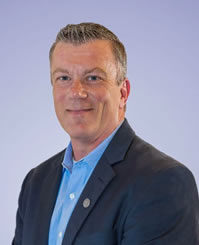Many farmers want to transition to drip irrigation for its water saving benefits, but like with any system change, it can be expensive. Many growers look to government funding to cover 70% of the installation cost.
 Addressing Environmental and Water Challenges in Farming
Addressing Environmental and Water Challenges in Farming

Q&A with Mike Hemman, SVP and Head of North America | Netafim
Tell us about yourself and your company Netafim.
I joined Netafim in 2019 and currently serve as the company’s Senior Vice President and head of North America. In my current role I drive strategic growth through innovative market strategies, customer segmentation, product lifecycle management, and improvements in supply chain and manufacturing efficiencies. With decades of experience across crop protection, seed, and irrigation, I help address the challenges farmers face today through the innovation at Netafim.
Before joining the company I held leadership roles with companies such as Corteva Agriscience, Pioneer Seed, DuPont Crop Protection, and Dow AgroSciences.
Netafim is the precision agriculture business of Orbia and the inventor of drip irrigation, which was founded by farmers for farmers to address some of the most pressing challenges they face. As one of the leading innovators in the agriculture industry for the last 45 years, we know how to improve yields, reduce water, energy, labor, and nutrient costs. We have 110 locations, 35 subsidiaries, and 13 production plants globally – this has given us the experience to work with almost every type of land imaginable, from hospitable to harsh. We work closely with farmers to find customized solutions that will support their specific crop on their unique plot of land. Netafim provides solutions beyond our legacy drip irrigation products. We are the go-to resource for all farming needs, from water systems, to reservoirs and everything in-between.
Can you please discuss your new corporate partnership program and how something like this will be impactful to farmers?
Netafim is launching the first-of-its-kind corporate partnership program, which aims to match corporations and farmers, both with the goal of increasing sustainability in agriculture. This program will connect companies seeking to meet corporate environmental goals with farmers looking for direct funding for projects that will decrease their operation’s environmental impact. Many farmers want to transition to drip irrigation for its water saving benefits, but like with any system change, it can be expensive. Many growers look to government funding to cover 70% of the installation cost and with this new program, Netafim can help bridge the final financial barrier for growers that want to install drip irrigation. Corporate funding for agricultural projects can be categorized into three categories:
Carbon reduction: Reduces emissions from current practices
- In carbon, it's the metric ton carbon dioxide equivalent (CO2e) associated with the outcomes from a practice change (i.e. irrigation changes)
Water stewardship: Reduces water demand (including groundwater pumping reductions) and/or improves water quality resulting from precision nutrient application
- With water stewardship, the total credit the partnering corporation receives is commensurate to the percentage of the project it funds
Regenerative agriculture: Improves acres of land through practices that positively impact soil health
- In regenerative agriculture, it's typically based on the number of acres for which certain practices are implemented While many companies have established sustainability goals in recent years, some of the highest concentration comes from Food and Beverage (F&B) and Tech companies. Netafim has seen project sizes that vary from 80-220 acres and that attract corporate funding anywhere between $50K - $2M. The average contribution is approximately $100k.
This program focuses on transitions toward drip irrigation systems. Can you discuss why this program focuses on supporting transitions to drip and the differences to other irrigation systems in the market?
Drip irrigation provides a higher level of control when compared to other irrigation systems. It experiences little to no water waste when compared to pivot or flood, whose broad irrigation is prone to experience evaporation and leaks caused by age, and condition of canals and/or pipelines. Studies have shown that this method provides a 95% - 100% efficiency when compared to pivot irrigation that is 10% - 15% less efficient. This has resulted in a 25% water use reduction, allowing growers to achieve the same yield on the same land with only 75% of the water currently used. Drip irrigation provides farmers with the opportunity to reduce water usage so that they can use more of their land and grow more crops with the same amount of water they are allotted. This results in higher yields and revenue without more water. Beyond water conservation it allows for precise deployment which stops under and over irrigation, which can cause root rot and lower yields and productivity. This also helps avoid fertilizer waste ensuring that the exact amount is getting to crops directly to its root zone. As a result, it also mitigates pollution to soil, water, and environment vastly improving quality and quantity by preventing runoff or evaporation releasing gasses into the air. Drip irrigation has a significant impact on reducing costs, labor, energy, water consumption, and nitrous oxide emissions.
When it comes to public funding toward water conserving irrigation, the government has invested millions towards cost-sharing. What is the private companies interest in supporting farmers and investing thousands to millions of dollars on these types of projects?
Corporations are increasingly scrutinized around their sustainability commitments. Corporate partnerships with growers can help these companies meet their metrics through targeted project investments. Companies can count their direct investments into farms toward their sustainability goals. Their participation in the Partnership Program can contribute to carbon reduction and/or water conservation.
For example, data centers have been noted as high energy and water consumers in the areas where they are located. For their stakeholders and their customers, their environmental impact is increasingly important so they are constantly seeking ways to demonstrate a positive effect in their community. With the Partnership Program, they can offset their impact on the local environment by financing a project that can be a net positive. More companies are looking for ways to meet their sustainability commitments and comply with government regulations and this program represents an opportunity for the AG industry to pair these corporate dollars with public funding to create significant change.
You’ve mentioned that you have previously worked with Google and Keurig Dr Pepper to connect them with farmers who they could partner with. Can you talk about those projects, the size, the funding amount, and its outcome?
Keruig Dr Pepper (KDP) sought annual volumetric benefits over a 10 year period as part of their water stewardship commitment in California’s Sacramento and San Joaquin hydrologic regions. KDP aspires to achieve Net Positive Water Impact by 2050. This means we are working to reduce water stress by focusing on water availability, quality and access and that our contributions exceed impacts on water stress in the same region. To accomplish this we were able to connect them with two different farmers in the region where over 469 acres were converted from flood irrigation to drip. The outcome resulted in a decrease of evaporative losses through precise water and nutrient delivery improves water quality, reduces greenhouse gas (GHG) emissions associated with traditional fertilizer application and reduces nutrient leaching to waterways. Google also sought volumetric benefits as part of their water stewardship. Netafim was able to identify and initiate a partnership with a farmer from Dos Palos, California to convert 215 acres of farmland from flood to drip irrigation.
This helped minimize evaporative losses through precise water and nutrient delivery. It improved water quality, reduced greenhouse gas (GHG) emissions associated with traditional fertilizer application and reduced nutrients from leaching to waterways. The partnership also reduced soil disturbance from flood irrigation resulting in consistent moisture levels which enhanced microbial activity in the soil, improving the soil’s ability to sequester GHGs by optimizing soil moisture conditions
What do you hope this initiative accomplishes long-term, and how do you see it evolving in the coming years? Do you feel private funding will need to continue to fill the public funding gaps?
One of our goals is to drive awareness for mutually beneficial collaborations like this between farmers and corporations. Currently, it’s not widely known that financing for these types of projects can count toward environmental commitments. At a time when farmers are experiencing so many economical hardships due to various elements, we need to be innovative about driving impact that will significantly support farmers, large and small. Our hope is that we are able to help drive financial support into the hands of farmers, who would otherwise be resigned to continue less efficient modes of irrigation, costing them time, resources, money, and labor that could be better spent in other areas of their farms. We continue to see family farms falling away because of the realities that continue to make it difficult for growers to operate. We want to present an opportunity where public funding can be paired with corporate dollars to significantly change the trajectory of farming today. Together, we can uplift the people that make it possible for everyone to have food on their tables.
 Mike Hemman joined Netafim in 2019 as the President of Netafim USA and was promoted to Senior Vice President of North America in 2024. He has been instrumental in driving strategic growth and expanding profit margins through innovative market strategies, customer segmentation, product lifecycle management, and improvements in supply chain and manufacturing efficiencies.
Mike Hemman joined Netafim in 2019 as the President of Netafim USA and was promoted to Senior Vice President of North America in 2024. He has been instrumental in driving strategic growth and expanding profit margins through innovative market strategies, customer segmentation, product lifecycle management, and improvements in supply chain and manufacturing efficiencies.
With multiple decades of experience in the crop protection and seed industry, Mike has held key
commercial leadership positions at DuPont, Corteva, and Pioneer Seed.
His extensive background in biologicals, fertility, crop protection, seed, and irrigation give him a
unique cross-sector perspective on the agricultural industry.
Mike holds a Bachelor of Science degree in Plant Science from California State University, Fresno, where he also pursued Master of Science coursework in agronomy. He is currently a member of the Executive Board of the Irrigation Association and has previously served on the boards of the Agricultural Retailers Association, Western Plant Health Association, and California Association of Pest Control Advisers.
The content & opinions in this article are the author’s and do not necessarily represent the views of AgriTechTomorrow
Comments (0)
This post does not have any comments. Be the first to leave a comment below.
Featured Product

